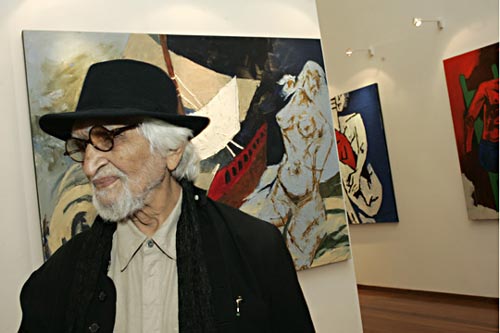The Arts House, Singapore
6-11 October 2005

MF Husain in front of painting depicting Ocean Queen Rocks the Ship
At the age of 90, MF Husain is, perhaps, India's best-known painter. During his long career as an artist, he has witnessed history as an active participant and observed the rapid deterioration of human values in all corners of the world. Through his art, he has expressed this decline as a great loss. He terms it 'The Lost Continent'. In an interview conducted in India's Sunday Tribune on the occasion of his 88th birthday, Husain said, 'I don't believe that a painter is special or gifted. The only gift a human being has is his passion. Without fire, he's just normal. Mind you, there's nothing wrong with being normal. Just as long as you are a good human being, nothing matters'.2
This statement might come as a surprise to those familiar with Husain's reputation for seeking publicity and actively provoking controversy. With many years of press coverage behind him, Husain now enjoys celebrity status. But as a young and poor artist, he experienced the value of human connection, when renowned Indian painter, NS Bendre, took him on as a protégé. While his paintings now demand enviable sums at auction (among the 21 paintings featured in this exhibition, 'Empty Bowl at the Last Supper' has broken the sales record for contemporary Indian art at USD 2 million), Husain, a widower, continues to be known as the 'barefoot painter', who remains close to his seven children.
The experience of viewing the 21 canvases is like a journey through colour that blurs the specificity of time and place. The works were painted in a rented London apartment over a period of two months in 2005. The creation of these paintings took place 58 years after Husain, along with SH Raza, FN Souza, KH Ara, SK Bakre and HA Gade formed the Progressive Artists' Group in 1947. In this pivotal year, India became independent and committed itself to eliminating British influence on modern Indian art. At that point in his development, Husain broke from the dominant British Academic School and worked to develop a unique style that combined the sensuous female form from the classical period of the Guptas; the strong colours of the Basohli period miniatures; and Indian folk art. These elements have come to characterise Husain's signature style.
Each canvas measures 6 x 7.5 ft and was painted in oil. The works serve as windows into Husain's thoughts about lost human values. Recurring subjects from his earlier work can be found in this new series, including the image of a child separated from, or abandoned by, his mother. Husain expressed this in 'A New Born Child Held Gently By a Fallen Leaf' with the red, featureless face of a mother in the background. Another recurring image is the monkey figure, inspired from India's Hanuman myths. The figure can be seen in his paintings from 1928 to 1988, also making an appearance as a white monkey in his recent interpretation of 'Andy Warhol versus Marilyn Monroe' - in resonance with the posture of the dominant Andy Warhol figure and at the same time clinging on to the Marilyn Monroe figure fading into the background.
Husain's line casts into motion his energised pictorial spaces; his brilliant colours envelop the space with symbolic and expressive values; and his distinct human forms transform the narrative on the painting surface into an intimate experience of poetry. The motion of The Chinese painter, Xu Beihong (1895-1953), influenced Husain's use of horses in motion, that break free from the charioteer's control in 'Blind Horses' and 'The Blue Charioteer' is like a streak of white lightning consuming and dividing the pictorial space. In 'A Magician Dangles the Fortune Bird in a Cage', the bird in the cage is surrounded by a mosaic of riotous colour. The bird is held by the stark blue hands of a magician, who is covered in a white cloth and slowly considering his next tic-tac-toe move. The composition lures viewers into a terrain where play and uncertainty coexist.
The exhibition premiered in the Gamble Room of the Victoria and Albert Museum in London on 11 July 2005 and was followed by a month-long run at the UBS office in the city. The exhibition then travelled to Singapore, where it was inaugurated by the president of Singapore on 4 October at the Arts House in the Old Parliament Building.
Hwee Koon
References
1. Herwitz DA. Husain: Drawing, Painting, Water Colour, Graphic, Sculpture, Architecture, Photography, Tapestry. TATA Steel, 1988.
2. Sunday Tribune. Chandigarh, India, 14 September 2003.